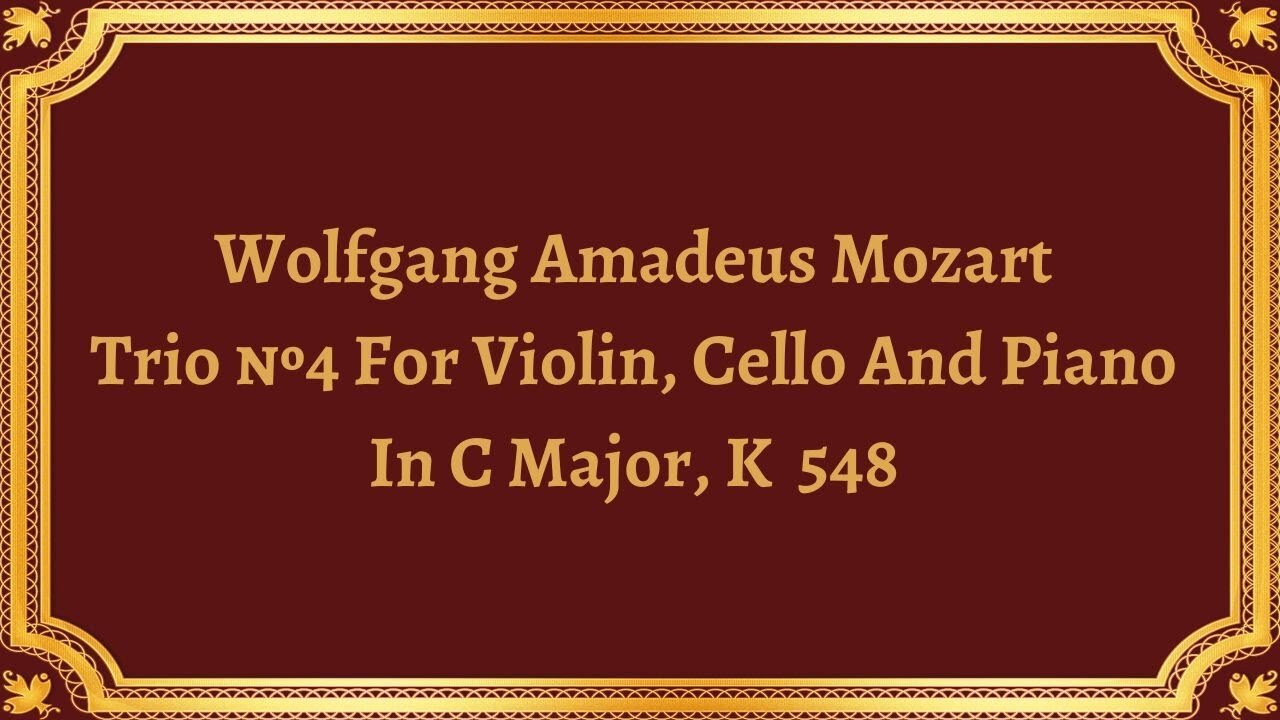Premium Only Content

Wolfgang Amadeus Mozart Trio №4 For Violin, Cello And Piano In C Major, K 548
#Mozart#Chamber_music#Classical_music#Trio#Musical_composition
Publication date 1954
Jean Fournier; Antonio Janigro; Paul Badura-Skoda
Wolfgang Amadeus Mozart is one of the most renowned composers of all time, and his contribution to classical music is unmatched. One of his notable pieces is the Trio No. 4 for Violin, Cello and Piano in C Major, K 548, which is a significant work that showcases Mozart's genius and musical mastery.
Mozart composed the Trio No. 4 for Violin, Cello and Piano in C Major, K 548 in 1788, during a period of creative productivity. He was already famous at this time, having achieved a great deal of success with his music. He was commissioned by a publisher to write three piano trios, which included K 548. The piece was completed in September 1788 and premiered at a private performance.
Trio No. 4 for Violin, Cello and Piano in C Major, K 548 is a three-movement work, with each movement having its own unique style and character. The first movement is in sonata form, and its lively and playful melody is characterized by the use of arpeggios and a variety of textures. The second movement, marked Andante cantabile, is in A minor, and it is a simple, expressive melody that showcases Mozart's ability to create beautiful melodies. The third movement, marked Allegro, is in rondo form and is characterized by its lively and joyful character. The cello and piano engage in a playful dialogue, and the violin provides a virtuosic solo.
The Trio No. 4 for Violin, Cello and Piano in C Major, K 548 is considered a mature work of Mozart's, and it showcases his ability to balance structure and emotion in his music. It is also notable for its use of a diverse range of textures, which adds to its musical complexity.
In conclusion, Trio No. 4 for Violin, Cello and Piano in C Major, K 548 is a significant work that highlights Mozart's genius and musical prowess. It is a three-movement work that showcases a range of styles and textures, and it is notable for its expressive melodies and intricate musical structure. Its historical significance and unique features make it a popular and enduring piece in the classical music repertoire.
-
 18:26
18:26
Classical music_Music Inspiration
1 month agoLudwig van Beethoven Sonata No. 14 in C-sharp minor, Op. 27, No. 2 "Moonlight"
811 -
 LIVE
LIVE
Badlands Media
6 hours agoBadlands Daily: Aug 1, 2025
1,449 watching -
 LIVE
LIVE
Matt Kohrs
9 hours agoTrump Tanks Stocks, Breaking Market News & Payday Friday || Live Trading
1,023 watching -
 13:42
13:42
China Uncensored
12 hours agoChina's Invasion Has Begun
1.63K11 -
 LIVE
LIVE
Wendy Bell Radio
5 hours agoBUSTED
8,972 watching -
 LIVE
LIVE
JuicyJohns
1 hour ago $0.46 earned🟢#1 REBIRTH PLAYER 10.2+ KD🟢$500 GIVEAWAY SATURDAY!
110 watching -
 LIVE
LIVE
LFA TV
13 hours agoLFA TV ALL DAY STREAM - FRIDAY 8/1/25
5,291 watching -
 4:02:39
4:02:39
The Bubba Army
23 hours agoHulk Hogan had Leukemia? - Bubba the Love Sponge® Show | 8/01/25
73K1 -
 18:36
18:36
DeVory Darkins
9 hours ago $4.53 earnedTrump scores MAJOR WIN with Americas youth as Biden drops HORRIBLE speech
18.5K31 -
 14:13
14:13
Clickbait Wasteland
15 hours ago $5.21 earnedAsking New Yorkers Who they Support for Mayor: Harlem
39.2K27